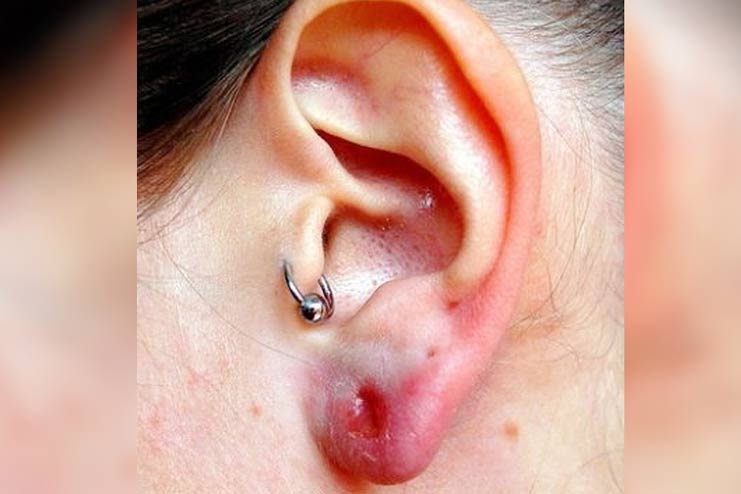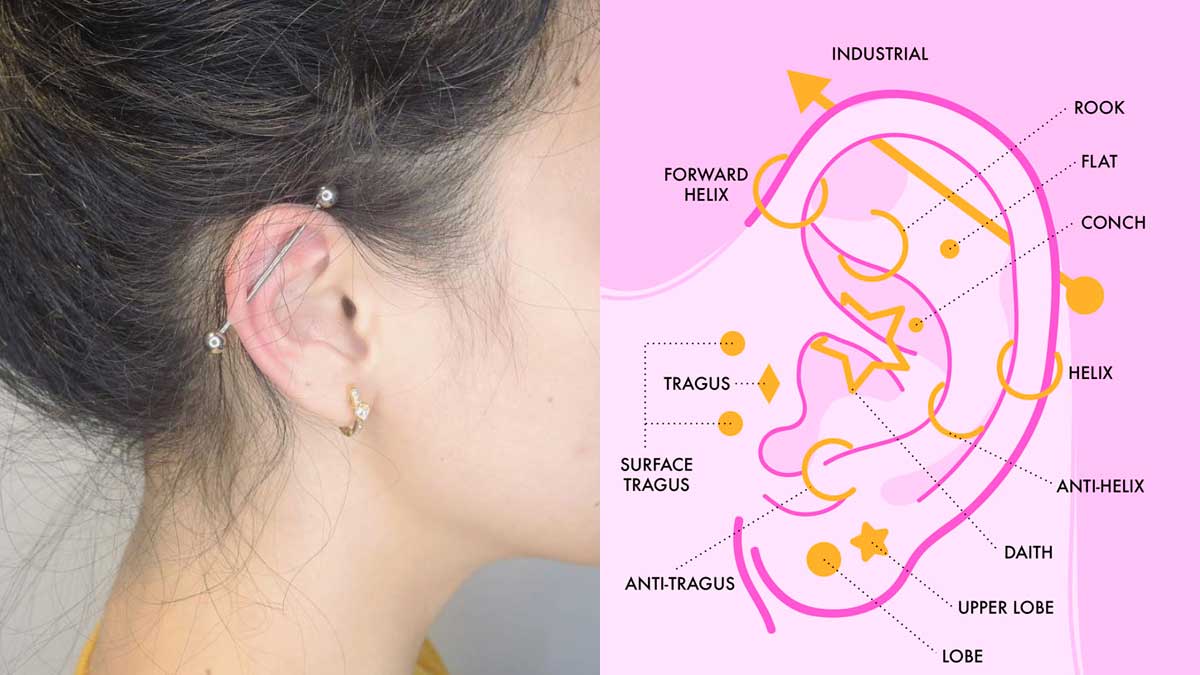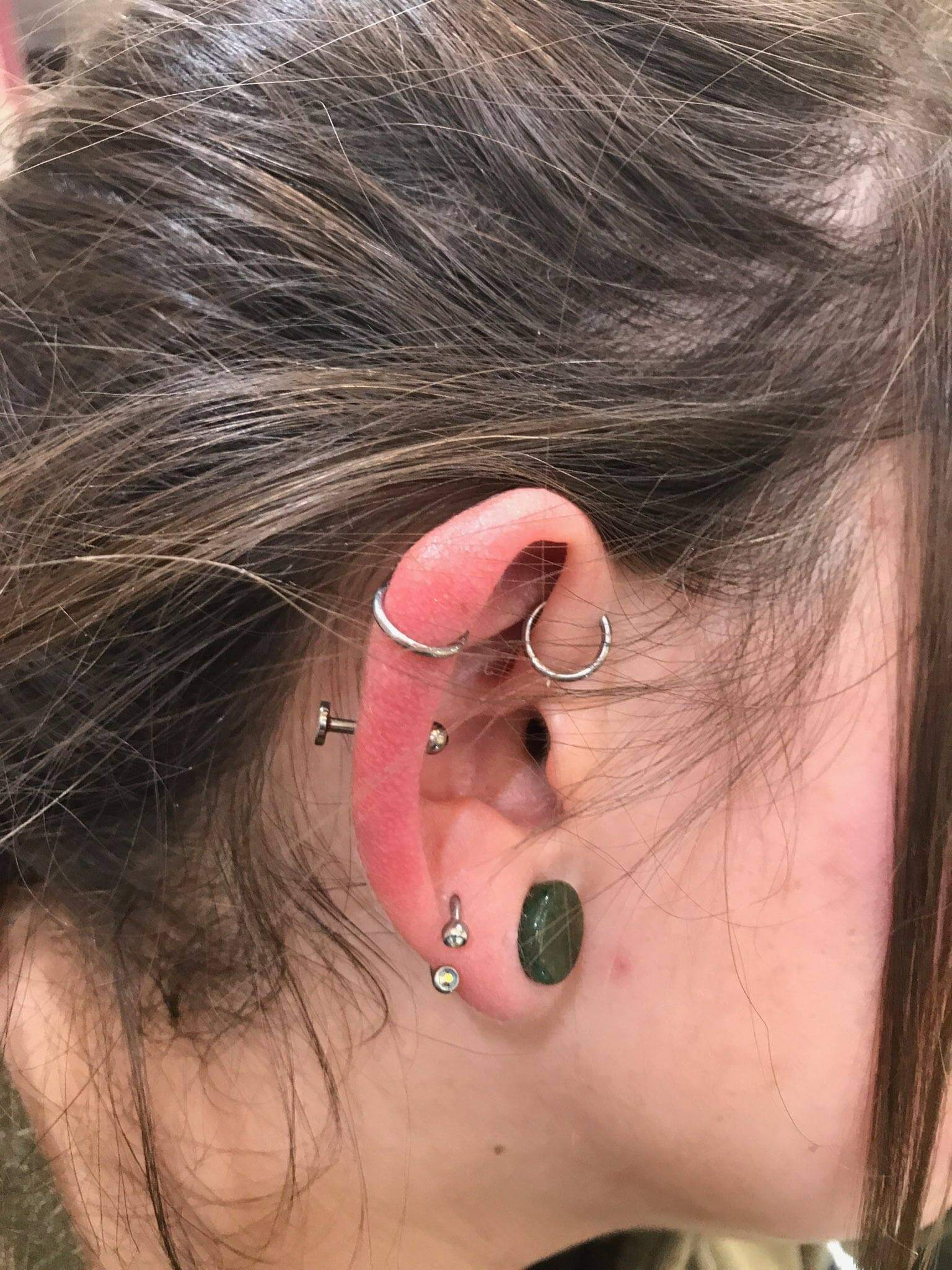Once you have washed and soaked the infected ear piercing, using a cotton swap, apply a small amount of antibacterial ointment to the area. Wash the earring itself with rubbing alcohol or hydrogen peroxide. Rinse it thoroughly, apply a little antibacterial ointment to the post, and reinsert the earring.
This might not feel very comfortable, but it is important to keep an earring in so that the hole does not close up and trap the infection inside the ear. To avoid further irritation or an allergic reaction, your earring should have a post made of 24-carat gold, silver, or surgical steel, and avoid earrings that contain nickel. The earring should not be removed for four to six weeks, but should be gently rotated each day. If the area of piercing becomes red or tender, an infection may be developing, and you should seek medical attention promptly. Most infected ear piercings are caused by a bacteria called Pseudomonas aeruginosa, and so you need an antibiotic that covers this bacteria, such as ciprofloxacin or levofloxacin.
Amoxcillin, Augmentin, and Keflex do not cover pseudomonas infections and are not the right drug to treat infected ear piercings. A.M. Boyle A washcloth lathered with soap is helpful in treating an infected ear piercing. An infected ear piercing can be painful and can become extremely problematic if not treated correctly and promptly.
If you suspect an infection, the area should be gently but thoroughly washed with a mild antibacterial soap and soaked with a warm saline solution. An over-the-counter antibacterial ointment should also be applied. If the infected piercing does not improve within three days, gets worse, or if you begin to run a fever, you should see your doctor immediately. Sometimes, an infection in the ear requires prescription antibiotics.
The first thing you should do if your ear piercing is infected is remove any crustiness with a cotton swab soaked in antibacterial soap or saline solution. Then, mix 1 cup of warm water and 3 spoonfuls of salt and apply the mixture to your infected piercing with a cotton swab. Hold a warm, moist compress against your ear for 20 minutes every day to help clear out the pus. Stay out of pools, lakes, rivers, or hot tubs until your infection is gone, and see your doctor if your infection persists. The basic steps in treating a wound infection include cleaning the wound, draining infected material and applying heat to promote circulation and stimulate the body's immune response.
Antibiotics are sometimes used depending on the location and severity of the infection. Cleaning and drainage generally involve soaking the wound with a saline solution and removing debris; dead tissue, pus, dirt or other foreign material. In the case of an infected piercing, doctors will often request for the jewellery to be removed and the piercing to be left to heal. It is very important for the piercee to discuss with the physician that the jewellery should remain in place to act as a drain. If the jewellery is removed, the openings of the piercing will close up and the infection will not be able to drain, which can result in an abscess.
An abscess is an infection that is trapped under the skin and is indicated by a darkening and hardening of the surrounding tissue, swelling and pain. This should be clearly explained to the piercee if it appears to be necessary. Should you notice a swollen tissue with pus inside around the earring hole, you might have an infected ear piercing.
That happens when your body aggressively reacts to a foreign object inside of it. Also, a constant piercing irritation may cause hypertrophic scarring, which makes the bump appear. In order to treat such a bubble, you may use sea salt, tea tree oil, aspirin and other remedies, recommended by professional piercers. The trend of body piercing at sites other than the earlobe has grown in popularity in the past decade. The tongue, lips, nose, eyebrows, nipples, navel, and genitals may be pierced. Complications of body piercing include local and systemic infections, poor cosmesis, and foreign body rejection.
Swelling and tooth fracture are common problems after tongue piercing. Minor infections, allergic contact dermatitis, keloid formation, and traumatic tearing may occur after piercing of the earlobe. "High" ear piercing through the ear cartilage is associated with more serious infections and disfigurement. Fluoroquinolone antibiotics are advised for treatment of auricular perichondritis because of their antipseudomonal activity. Many complications from piercing are body-site–specific or related to the piercing technique used. Navel, nipple, and genital piercings often have prolonged healing times.
Family physicians should be prepared to address complications of body piercing and provide accurate information to patients. Fresh ear piercings take anywhere from 4 to 6 weeks to heal. During this time, you should take the proper steps to care for your piercings to avoid infections. This means cleaning the piercings twice a day with rubbing alcohol or an antibiotic cream. You shouldn't take out your earrings during this time. In total, 7 of 53 people who had their upper ear cartilage pierced during that period were found to have Pseudomonas infections that were confirmed by cultures.
The people with confirmed infections ranged in age from 10 to 19; 2 were male, 5 were female. All 7 developed auricular chondritis -- cartilage infection of the outer ear -- within 3 days of having their ears pierced. Four were hospitalized, 1 to receive intravenous antibiotics, 2 to undergo incision and drainage of an abscess that formed at the site of the piercing and 1 for both reasons. If you have a minor ear piercing infection, you can easily treat it at home.
However, if you have recently gotten a cartilage piercing that has become infected, you might need to seek professional medical treatment. Cartilage infections are quite difficult to treat and often need orally-administered medications and antibiotics. Some cases of serious cartilage infections even require hospitalization. Within 24 hours after the piercing, the site became erythematous, painful and swollen.
The patient tried to treat the ear with a solution of boiled water and salt. Over the following four days, she experienced progressive pain and swelling followed by spontaneous purulent discharge from the site, prompting her to seek medical attention. The stud was removed, the posterior upper helix was incised, and pus was drained. Empirical treatment with cephalexin was started for the management of an abscess with surrounding cellulitis. After several days without improvement, a second drainage procedure was done, and intravenous treatment with cefazolin and clindamycin was started. A specimen obtained for culture yielded a pure growth of Pseudomonas aeruginosa that was sensitive to ciprofloxacin, ceftazidime and piperacillin–tazobactam.
Antibiotics were changed to intravenous ciprofloxacin. After three days, she was discharged home with a prescription for oral ciprofloxacin. Pus caused from a piercing may be treated with sea salt and water. Don't put alcohol or peroxide directly on the area of the infection as these chemicals are harsh and can cause further irritation. Try to avoid itching or playing with the infected area because doing so could spread the infection. Until the infection clears up, over-the-counter pain relievers can be taken to ease any discomfort you're experiencing.
If the infected ear piercing has not improved within three days or appears to be getting worse, you should see your doctor. Also, if you begin to run a fever, you should see your doctor right away. All the people talking about how they're fine after getting their cartilage done with a gun are probably unaware that it's just more of a risk.
You may be fine but there are other people who had their cartilage shattered because it is actually a thin bone. Also just because the gun is a faster and less expensive option than the professional piercing doesn't mean it is better. You usually get some 18 year old who gets paid like $10 an hour who isn't thinking about the structure of your ear and where the piercing will look the best. Also this upper cartilage piercings which are called helix piercings are only about $20-$35.
It might be more expensive but you're paying or the experienced professional with a license and sterile jewelry. Not even mentioning the amount of time the piercer spends ensure that their atmosphere is safe and welcoming. So yeah you pay more but you're getting a professional and better jewelry. If you want to treat an infected piercing without it closing, never take the jewelry out. The ear piercing infection would not go away, but the hole will surely close. Moreover, the removal will make your piercing hole irritated, and slow down the treatment process.
If the ear is infected from an earlobe piercing, clean around the area and take your time cleaning and rotating the earring. If the infection doesn't heal or is getting worse, call a healthcare professional. If there is an infected cartilage piercing, contact your healthcare provider so they can determine the severity of the infection and treat it. Body piercings are the new norm, and along with that new norm comes the need for a lesson on how to prevent or treat infected piercings.
No one wants an infected ear piercing, much less an infected lip or nose piercing. Doctors do not think well about the practice of cartilage piercing due to the associated health risks. If you want to anyways go for it, they recommend visiting a surgical center instead of a local studio or mall. This is because, without proper sterile precautions and other safety measures, cartilage piercings carry a high risk of infections at the pierced area, which can delay the healing.
The only treatment that remains is the removal of the dead cartilage. And without the cartilage, the shape of your ear gets altered. Above all, the reconstruction surgeries of the deformed ears are difficult to perform. Whether you just got your ears pierced or are a piercing veteran, there are a number of reasons you might end up with an earring hole infection. Fresh piercings, especially, are pretty vulnerable, and can actually take up to six weeks to heal.
"An earlobe piercing is essentially an open wound until it fully heals, so during this time, like any other wound, it is susceptible to infection," Shah said. Even with proper care, about 20% of earlobe piercings become infected and 30% of cartilage piercings become infected. Most commonly, an infected ear piercing is caused by bacteria entering the wound, which can happen in several ways. If you have signs of infection, such as fever and chills or a discharge of blood or pus, seek medical attention immediately. The doctor may prescribe topical or oral antibiotics to treat the infection and avoid further complications.
She had her upper ear cartilage pierced at a reputable jewelry store using sterile conditions and gold earrings. She cleaned the piercings appropriately with antiseptic solution. But five days later her cartilage piercings became infected, a medical emergency. Typically, ear lobe piercings heal in about six weeks, with cartilage piercings taking longer. And despite your urge to rotate the piercing—don't. "Twisting and turning a new piercing could damage the delicate skin and hinder the healing process," says Dr. Nichols.
It can also expose your new piercing to germs and other bacteria on your hands, which could lead to another infection and scarring. You may be able to take care of it at home with minor infections. However, seek medical treatment if you've had a cartilage piercing and it seems infected. Oral antibiotics may be required as these infections can be difficult to treat.
In severe infections, hospitalization may be necessary. To treat a minor infection, follow the steps below. Essentially, a piercing is essentially an open wound. In order for it to heal, an earlobe piercing usually takes about 6 to 8 weeks.
Generally taking longer to heal and being more prone to infection, cartilage piercings take place on the harder part of your ear. Today, we at theENT Specialistswould like to elaborate on ear piercing infections. As long as your infection is minor, you may be able to take care of it at home. If you've had a cartilage piercing and it seems infected, seek medical treatment. These types of infections are harder to treat and may require oral antibiotics.
Significant infections of the cartilage can require hospitalization. This article is helpful, however I got my helix pierced 1.5 months ago and it was done with a gun in a fully licensed place and it was good! No pain at all and nothing bad happened (I am sure you can't sue salon for using the gun, it is the matter of personal preference).
I would say for 2 weeks after your piercing has been done using peroxide is good for avoiding any infections . If the piercing site is red or you are worried about getting an infection, remove the jewelry. Soak the site in warm water for 20 minutes, 3 or 4 times a day.
If it is too hard to soak the piercing site , apply a warm, moist cloth instead. If the site looks or feels worse during home treatment, check your symptoms to find out if you need to see your doctor. An infected ear piercing may cause a low-grade fever and fatigue. When washing an infected ear piercing, make sure you use a mild antibacterial hand soap.
Before washing, carefully remove the earring, and using a soft cloth or tissue, squeeze the area slightly to clear away any puss or discharge that might be present. Work up a good lather on a soft washcloth, and gently clean the area, rinsing it thoroughly when done. Treatment with 2 percent mupirocin ointment or oral antistaphylococcal antibiotics may be warranted. To make a saline solution, mix 1/2 teaspoon of salt into a 1 cup of warm water.
Dab a sterile cotton ball or gauze into the solution and gently sweep it over both sides of the ear at the site of the piercing. Do this twice a day to keep the area clean.The area may sting slightly when you use the solution. This also makes it more susceptible to infection and harder to treat. Destruction of cartilage by an infection can also lead to deformity of the ear or nasal contours. While most of these infections still clear well with early use of antibiotics, it is a risk that you should know about. While these steps will help you treat an infected ear piercing, you need to remember that prevention is better than cure.


























